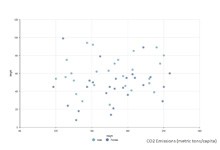

Coordinates to be used for positioning the label,Įxpressed in "normalized parent coordinates".Īllowed values include: i) one of c('right', 'left', 'center', 'centre', Vector of the same length as the number of groups and/or panels. formulaĪ formula object label.x.npc, label.y.npc A function can be createdįrom a formula (e.g. Seeįortify() for which variables will be created.Ī function will be called with a single argument, All objects will be fortified to produce a data frame. If NULL, the default, the data is inherited from the plotĭata as specified in the call to ggplot().Ī ame, or other object, will override the plotĭata. You must supply mapping if there is no plot Inherit.aes = TRUE (the default), it is combined with the default mappingĪt the top level of the plot. It is a lot of fun! And email me at if you need more help.Set of aesthetic mappings created by aes(). Try them out to discover new shapes and possible regressions that you can calculate. This indicates that we should perform a quadratic regression.įrom this screen, you can also click on the other trendline options. That is a lot! And it also seems that our trendline fits our data very well. Now, we see that the quadratic trendline explains 92.5% of the variance in our data.

If it didn’t, try clicking on the, “Display R-squared value on chart”, button off and on again, and it should properly reappear. A second-order polynominal trendline is the same as a quadratic trendline.Ī new trendline should appear – one with a single curve. Now, try clicking on “Polynomial” on the right-hand side of your screen. This indicates that the current linear trendline on our chart explains very little of the variance in our data. I made mine bigger for visibility purposes, but, if you are using the example dataset, your equation should be R^2 = 0. Let’s start by pressing, “Display R-squared value on chart”, at the very bottom.Īn R^2 equation should appear on your chart. It is highlighted below.Ī new set of options should now appear. Click on the mini-bar chart in this new window. Do NOT click on the word, “Trendline”, or else it will automatically add a trendline that you do not want.Ī “Format Trendline” window should appear on the right side of your screen. Then, click on the phrase, “More Options…”. Click on the arrow next to the word, “Trendline”. The “+” symbol in the upper right corner should appear. I went ahead and reformatted it to have correct labels, but this is not required. Make sure that your chart looks like the one below if you are following along with the example dataset. Voilà! We now have a chart! But we aren’t done yet. Click on the new highlighted button below. Once you click on that button, a new menu should pop up. Highlight your data by clicking and dragging, then click on the highlighted button below. Specifically, we predict that life satisfaction is highest when conscientiousness is moderate, whereas life satisfaction decreases when conscientiousness is either low or high.Īs you can see, we have a predictor variable (conscientiousness) and an outcome variable (life satisfaction).įirst, let’s start by making a simple chart of the data in Excel. In this dataset, we are looking at the relationship between conscientiousness and life satisfaction.
OVERLAY A QUADRATIC AND LINEAR SCATTER PLOT DOWNLOAD
Fortunately, we can do this in Excel.Ĭlick here if you need to download the example dataset. It is sometimes difficult to know when to apply quadratic regression, but creating a scatterplot and adding a quadratic trendline can help you make this decision. If you need a refresher about the purpose of quadratic regression, check out my guide on calculating quadratic regressions in Excel. As always, if you have any questions, please email me at quadratic regression models a relationship using a single curve, such as the “too much of a good thing” effect. While there are many approaches to help you make this decision, this guide reviews one of the easiest approaches – creating a scatterplot and visually identifying whether a quadratic trendline fits your data. Sometimes it is difficult to know when to conduct a quadratic regression.


 0 kommentar(er)
0 kommentar(er)
